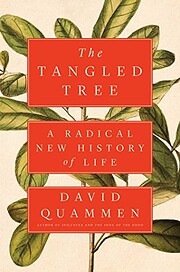

Fai clic su di un'immagine per andare a Google Ricerca Libri.
|
Sto caricando le informazioni... L'albero intricato (2018)di David Quammen
 Books Read in 2022 (3,543) Sto caricando le informazioni...
Iscriviti per consentire a LibraryThing di scoprire se ti piacerà questo libro. Attualmente non vi sono conversazioni su questo libro.   ) )One of the best science books I've read. the story hinges on Woese , discover/definer of Archaea.a cantankerous but insightful biologist who chased new insights despite not getting on with his colleagues (and competitors). but the book's triumph is to bring us up to date with how the history of life now understood in the light of half century working with DNA, the "Tree" is an inaequate metaphor. Early life and microbial life does not follow the conventional rules of inherited DNA, much of it is lateral transfer of genetic material, still an important part of microbial life , including among the pathogens. When I was applying to universities for undergrad, my dad told me my future career field might not even be invented yet, and though not currently employed in what I studied he was right- my graduate work involved examining the lineages based on two genes of a plant-parasitic nematode and its endosymbiotic gut bacteria partner, including one of the genes that gets covered here, 16S rRNA. Horizontal gene transfer really took research by storm within the last decade or so, and The Tangled Tree covers much of the groundwork laid earlier by Lynn Margulis, Ford Doolittle, and most especially Carl Woese. Sometimes, i think of HGT as a vindication of sorts for Lamarck, and while he does get mentioned a few times, Tangled Tree serves partially as a biography of Carl Woese, a physicist-turned-molecular-biologist who spent decades examining radioactive 'fingerprints' on a gel to determine what molecule coded life, and if so could we determine relatedness/age based on similarities. I'm only two years out from my masters, so in many ways this was like revisiting old neighbors who I'm familiar with but couldn't remember specifics. I can't tell how well Quammen conveys the idea of horizontal transfer and endosymbiosis to a lay audience- it seems well put together to me, but not sure if I'm the target audience. It's a good read, though, and if you need a story to go with your science (what teams made the discovery, what avenues did they explore before getting there, etc.) then this is the book for you. For a purely mechanical discussion of concepts though, a textbook may be more appropriate. The author says that this is a history of molecular phylogenetics. It is and I also think of it as a personal biographical and gossipy approach to the history of the development of the idea of the phylogenetic tree. Principal topics are the discovery of the archaea, the discovery of endosymbiosis in eukaryotes by chloroplasts and mitochondria, the discovery of lateral gene transfer - first in bacteria and then everywhere, and, in a flurry at the end, the microbiome, transposons, endogenous retroviruses, and CRISPR. The book is organized historically, and largely around the life and relationships of Carl Woese. Until I finished it I thought this book to be a standard 4 star work, but, as it ended, it made me think of many other things not directly discussed, including my own career, and I’ve gone full five stars on it. ====================== The author uses kibitz in a non-standard way to seemingly mean that he had monitored a class. nessuna recensione | aggiungi una recensione
Premi e riconoscimentiMenzioniElenchi di rilievo
"In the mid-1970s, scientists began using DNA sequences to reexamine the history of all life. Perhaps the most startling discovery to come out of this new field--the study of life's diversity and relatedness at the molecular level--is horizontal gene transfer (HGT), or the movement of genes across species lines. It turns out that HGT has been widespread and important. For instance, we now know that roughly eight percent of the human genome arrived not through traditional inheritance from directly ancestral forms, but sideways by viral infection--a type of HGT. In The Tangled Tree David Quammen, "one of that rare breed of science journalists who blends exploration with a talent for synthesis and storytelling" (Nature), chronicles these discoveries through the lives of the researchers who made them--such as Carl Woese, the most important little-known biologist of the twentieth century; Lynn Margulis, the notorious maverick whose wild ideas about "mosaic" creatures proved to be true; and Tsutomu Wantanabe, who discovered that the scourge of antibiotic-resistant bacteria is a direct result of horizontal gene transfer, bringing the deep study of genome histories to bear on a global crisis in public health. "Quammen is no ordinary writer. He is simply astonishing, one of that rare class of writer gifted with verve, ingenuity, humor, guts, and great heart" (Elle). Now, in The Tangled Tree, he explains how molecular studies of evolution have brought startling recognitions about the tangled tree of life--including where we humans fit upon it. Thanks to new technologies such as CRISPR, we now have the ability to alter even our genetic composition--through sideways insertions, as nature has long been doing. The Tangled Tree is a brilliant guide to our transformed understanding of evolution, of life's history, and of our own human nature." -- Publisher annotation. Non sono state trovate descrizioni di biblioteche |
Discussioni correntiNessunoCopertine popolari
 Google Books — Sto caricando le informazioni... Google Books — Sto caricando le informazioni...GeneriSistema Decimale Melvil (DDC)591.3Natural sciences and mathematics Zoology Specific topics in natural history of animals Genetics, evolution, developmentClassificazione LCVotoMedia: (4) (4)
Sei tu?Diventa un autore di LibraryThing. |
||||||||||||||||||||||||||||||||||||||||||||||||||||||||||||||||||||||||||||||||||||||||||||||||||||||||||||||||||||||||